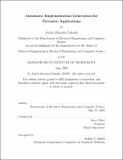| dc.contributor.advisor | Steve Ward. | en_US |
| dc.contributor.author | Paluska, Justin Mazzola, 1981- | en_US |
| dc.contributor.other | Massachusetts Institute of Technology. Dept. of Electrical Engineering and Computer Science. | en_US |
| dc.date.accessioned | 2005-05-17T14:54:47Z | |
| dc.date.available | 2005-05-17T14:54:47Z | |
| dc.date.copyright | 2004 | en_US |
| dc.date.issued | 2004 | en_US |
| dc.identifier.uri | http://hdl.handle.net/1721.1/16681 | |
| dc.description | Thesis (M. Eng.)--Massachusetts Institute of Technology, Dept. of Electrical Engineering and Computer Science, 2004. | en_US |
| dc.description | Includes bibliographical references (p. 69-71). | en_US |
| dc.description | This electronic version was submitted by the student author. The certified thesis is available in the Institute Archives and Special Collections. | en_US |
| dc.description.abstract | Pervasive computing promises to put computers in almost every corner of our life. Unfortunately, it also promises to make programmers' jobs harder since they cannot know what components are available in the run-time environment and as such, cannot statically plan out their programs. To help this situation, we propose goal-oriented programming, which may be more amenable to programming pervasive applications. Goal-oriented programming adds a level of indirection between Goals, high-level intentions such as "make me available for chat," and Techniques, the code that implements the intentions. Each Technique is a combination of code and prerequisite subgoals, so that a Technique can be itself goal-oriented. By decomposing an application this way, it is possible to automatically build parts of it based on the runtime environment. When an application would like a Goal satisfied, the implementation Planner first finds Techniques that can satisfy the Goal, and then recurses to satisfy the Techniques' subgoals. After a sufficient number of Techniques are found, the Planner evaluates the Techniques in some user-defined way, and chooses a set to execute. This work focuses on programming framework that isolates the planning aspect of goal-oriented programming from the Goals and Techniques themselves. We provide a reference Planner and evaluate its how well the Planner performs in simulation. | en_US |
| dc.description.statementofresponsibility | by Justin Mazzola Paluska. | en_US |
| dc.format.extent | 71 p. | en_US |
| dc.format.extent | 844575 bytes | |
| dc.format.extent | 842749 bytes | |
| dc.format.mimetype | application/pdf | |
| dc.format.mimetype | application/pdf | |
| dc.language.iso | eng | en_US |
| dc.publisher | Massachusetts Institute of Technology | en_US |
| dc.rights | M.I.T. theses are protected by copyright. They may be viewed from this source for any purpose, but reproduction or distribution in any format is prohibited without written permission. See provided URL for inquiries about permission. | en_US |
| dc.rights.uri | http://dspace.mit.edu/handle/1721.1/7582 | |
| dc.subject | Electrical Engineering and Computer Science. | en_US |
| dc.title | Automatic implementation generation for pervasive applications | en_US |
| dc.type | Thesis | en_US |
| dc.description.degree | M.Eng. | en_US |
| dc.contributor.department | Massachusetts Institute of Technology. Department of Electrical Engineering and Computer Science | |
| dc.identifier.oclc | 57138193 | en_US |
